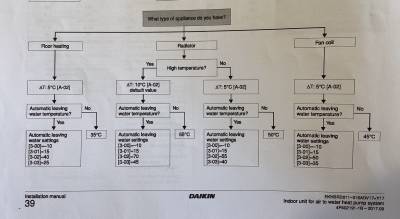Meaning of ΔT setting in an ASHP
Hello to everyone here, this is my first post.
I own a 16kW an inverter motor ASHP from Gree with which I am heating three zones each with a thermostat and an electrovalve. I am setting the WOT (water out temperature) of the water to say 50oC and I can set a ΔT of this temperature anywhere between 3-10oC.
Can someone explain to me the meaning of this ΔT temperature?
Thank you!
Posted by: @universal_mindHello to everyone here, this is my first post.
I own a 16kW an inverter motor ASHP from Gree with which I am heating three zones each with a thermostat and an electrovalve. I am setting the WOT (water out temperature) of the water to say 50oC and I can set a ΔT of this temperature anywhere between 3-10oC.
Can someone explain to me the meaning of this ΔT temperature?
Thank you!
DeltaT basically means temperature difference, which in your case will be the DeltaT between the WOT and WIT (water in temperature) at your heat pump.
There will also be a DeltaT between the water entering your heat emitters (radiators or UFH), and between the indoor temperature and the outside temperature.
Thank you Derek for your answer.
So I guess that more or less the operation logic of the heat pump is to adjust the power of the VFD compressor so that the WOT is at setpoint (e.g 50oC) and to adjust the power of the VFD water circulator so that the ΔΤ (WOT-WIT) is at setpoint (e.g. 7oC) which means WIT of 43oC.
Do I get it right?
Yes, if the compressor and water pump have Variable Frequency Drives (VFD) controlling their motor speeds. It actually varies the frequency of the electricity supplied the the motor, which in turn varies the speed. I think that most modern heat pumps have speed control of the compressor, but as we appear to be finding out, not all have control of the water pump speed.
Some heat pumps can also control the air fan speed.
For example when i use this simulator:
Assuming that we don't have an electric element but an ASHP, I see that for a given thermal load (e.g. 4kW) and therefore given frequency of the compressor of the inverter, the only way for the ASHP control to adjust ΔΤ according to the set value is by varying the frequency of the water pump and therefore altering the flow rate.
What would an optimum ΔΤ setpoint be and how it should be determined?
Thank you!
It is my understanding that many of the heat pumps vary the compressor speed to control the LWT, and vary the water pump speed to produce the desired DeltaT, which is often set at 5C.
As the simulator clearly demonstrates, there is some interaction between LWT and flow rate, in that varying one can affect the other, particularly at the extremes. I suspect that the overall performance of the system will be dependent upon what equipment has been installed, and how the algorithms within the controller balance the operation of the system.
In a heat pump system, best overall efficiency is normally achieved with the lowest LWT that meets the heat demand. Having large heat emitters can significantly lower the required LWT, but they also need to be balanced throughout the home. It is rather pointless having an oversized heat emitter in one room, that can take the temperature up to 25C, if the remaining rooms struggle to get to 20C with their heat emitters. The minimum required LWT will be dictated by the room with the lowest ratio of heat emitter output to heat demand.
The other primary requirement is to reduce the heat demand, by improved insulation and draft proofing, though ideally this should be carried out prior to the heat loss calculations and sizing of the heat pump.
Some say that as a rule of thumb we should set 10 degrees for radiators, 7 for FCU and 5 for UFH. Does this sound valid?
@universal_mind I'be definitely seen those figures repeated in my reading around this. Not to confuse your thread, but we have a single system controller that allows me to set the delta T. I have two zones - one UFH, and one radiators. So my additional q would be what should the delta T be set to in this scenario, and what effect would that have on the other emitters? That is, if I set delta T to 5, would that make the rads run less efficiently? And if I set it 10, would the UFH not run as efficiently? I know I can test this but wondered if the answer and explanation was already out there.
Posted by: @universal_mindSome say that as a rule of thumb we should set 10 degrees for radiators, 7 for FCU and 5 for UFH. Does this sound valid?
The general consensus for ASHPs (rads or UFH) is that delta T should be 5C.
Pre-order: The Ultimate Guide to Heat Pumps
Subscribe and follow our Homeowners’ Q&A heat pump podcast
@editor Actually just went back to my Daikin manuals as I was posting from a memory of reading generally 5 for UFH, 10 for rads in the operation manual, and it seems in the installation manual they actually say 5 for for UFH, 10 for HT rads, 5 for low temp rads.
I've read those manuals dozens of times and never noticed that. Daikin manuals really are gifts that just keep giving.
Posted by: @marzipan71@universal_mind I'be definitely seen those figures repeated in my reading around this. Not to confuse your thread, but we have a single system controller that allows me to set the delta T. I have two zones - one UFH, and one radiators. So my additional q would be what should the delta T be set to in this scenario, and what effect would that have on the other emitters? That is, if I set delta T to 5, would that make the rads run less efficiently? And if I set it 10, would the UFH not run as efficiently? I know I can test this but wondered if the answer and explanation was already out there.
It would appear that DeltaT has become a topic of interest recently, so it may be useful to investigate why DeltaT is required, what is the primary cause, and how it may be controlled.
Consider a hypothetical home, similar to many, though not necessarily typical.
Heat loss of 12kW, with an indoor temperature of 21C at an outside temperature of -3C. Twelve 2kW radiators, providing a maximum heating capacity of 24kW at a DeltaT of 50C, between the water temperature and the indoor temperature. What I am uncertain about is if the 50C temperature difference relates to the water supply temperature, or the average radiator temperature.
If the outside temperature is 9C, the heat loss will be approximately 6kW, so to keep the inside temperature at 21C, will require a heat output of 500W from each radiator.
In a gas boiler based heating system, a DeltaT of 20C is often mentioned, which would possibly mean a water supply temperature of 71C, a water return temperature of 51C, giving an average temperature of 61C. This being to provide the specified output of 2kW per radiator.
To provide a similar heat energy output from a heat pump with a DeltaT of 5C, would require a supply water temperature of 63.5C, a return water temperature of 58.5C, again giving an average of 61C.
Obviously, this is a much greater heat energy supply than is required, and would also be undesirable from the efficiency point of view.
To provide 500W of heat energy from each radiator would require an average radiator temperature of 38.2C, so with a gas boiler system this should require a water supply temperature of 48.2C and a water return temperature of 28.2C. With a heat pump system this would equate to a water supply temperature of 40.7C and a return water temperature of 35.7C.
The root cause of the DeltaT at the heat pump is the radiators, since they are absorbing energy from the water as it flows around the system. The two main factors which dictate the amount of heat energy which is absorbed, and dissipated, by the radiators is the supply water temperature, and to a lesser extent the water flow rate. If the volume of a radiator is 8 litres, and water is flowing through the radiator at a rate of 1 litre per minute, then on average each molecule of water will spend 8 minutes inside the radiator. During this 8 minute period, the water will be transferring heat energy through the metal to the room at a rate dictated by the difference in temperature between the water and the air. The return water leaving the radiator could therefore be 5C lower than the supply water.
What would be the effect of keeping the supply temperature constant, but doubling the flow rate?
There should be little effect at the top section of the radiator, since the temperature gradient is still the same, but the water is now only spending 4 minutes inside the radiator, so only has half the time to perform the heat energy transfer, which would cause the return water temperature to increase. The amount of heat energy dissipated by the radiator will increase slightly, since the lower sections will now be slightly warmer than previously. The overall effect will be that the DeltaT at the heat pump may be reduced by 2C, from 5C to 3C.
It could be assumed that the increase in RWT at the heat pump would cause a corresponding increase in the LWT, but one should remember that the heat pump is now heating twice the quantity of water, during the same time period, so the LWT should remain approximately the same.
The slightly increased heat energy output at the radiator may cause the room temperature to rise slightly, which dependent upon the control philosophy could reduce the required LWT slightly, which in turn should slightly improve efficiency.
Control of DeltaT in some systems is achieved by varying the speed of the water pump, and hence the flow rate. This type of system would allow different DeltaT's to be tried to find the most appropriate, but again what is most appropriate could change from day to day.
At the end of the day there would appear to be no 'golden rule', and the best operating parameters will undoubtedly be different from system to system, and could also vary with weather and operating conditions.
@derek-m Hi Derek - many thanks for this explanation...I think I get it. I would guess in my Daikin setup the heat pump internal unit has the ability to control the flow rate (presumably via the internal unit's pump, indicated in the manual, per pic below - mine is 16kw) and water temps to deliver the delta T which can be set in the controller (I think!). I then have two additional external pumps - one for the UFH, one for the radiators. I have both of these set to '1' (lowest speed of 3). This setup is in line with that recommended for 2 different heat emitters in the Daikin manual (per diagram below, without the fan coil circuit). If the internal unit of the heat pump is altering the flow rate via its internal pump, do you think the external pumps have any effect? Do they modulate the flow rate - i.e., reduce or increase the flow rate according to their setting (1, 2, or 3) to something different to that intended by the brains of the Daikin side of things, or just boost whatever flow rate is determined by the Daikin unit? Or am I misunderstanding everything? If so, apologies.
One thing I've noticed that on the LWT/ RWT dials accompanying the external pumps, the indicated delta T is usually spot on for the UFH (delta t is 5 degrees), but always slightly lower for the radiators (delta t is 2 or 3 degrees). I don't know why that would be - although I've discovered my radiators were never balanced (all lock shield valves are fully open); and the UFH wasn't balanced either (all the blue caps are fully open - I don't have actuators - and the flowmeters fully open), or even labelled with the rooms on manifold pipes. Another odd thing about my UFH manifolds is that the blue caps are on the top row and the red flowmeters on the bottom row, which is the opposite to every photo of an UFH manifold I see here or on the interweb - it works, so not sure that is an issue, maybe just how they do it here in Italy (I should get that on a t-shirt).
- 26 Forums
- 2,152 Topics
- 47.2 K Posts
- 101 Online
- 5,671 Members
Podcast Picks
Latest Posts
-

RE: Midea ASHP – how to set weather compensation
So that's the flexible rubber pipe which connects to th...
By Transparent , 4 minutes ago
-

RE: Octopus tariffs - a quick comparison
I'm on Tracker at the moment and intend to remain on it...
By Scalextrix , 7 minutes ago
-

RE: Electricity price predictions
@bontwoody Totally agree. Even without a heat pump, if ...
By ChandyKris , 11 minutes ago
-

RE: is a home battery without an EV worth it?
In fairness when the grant went from £5000 to £7500, wh...
By JamesPa , 11 hours ago
-

@mars That response surely deserves a nomination for Tu...
By JamesPa , 12 hours ago
-

Specifying batteries, pv solar etc using ChatGPT
I thought I'd try to use ChatGPT to specify my requirem...
By Tim441 , 14 hours ago
-

RE: Ecodan & MelCloud scheduling
When I interviewed Mitsubishi Electric at Installer ear...
By Mars , 18 hours ago
-

RE: Rodents! A word of warning for heat pump owners
@lucia One look at that protection and the rodents will...
By Toodles , 19 hours ago
-

RE: What crazy nonsense are inverter limits and why are they imposed?
@transparent The only reason my DNO knows of these is b...
By Lucia , 23 hours ago
-

RE: A Customer's Lessons Learnt from a Heat Pump Installation in a Large House
🙁🙁🙁🙁🙁
By Lucia , 23 hours ago
-

What is the Heat Geek Guarantee?
We regularly hear from homeowners who are researching i...
By Mars , 2 days ago
-

RE: Help me keep the faith with my air source heat pump installation
@adamk, interesting point. I’ve not focused much on Hea...
By Mars , 1 day ago
-

Intelligent Octopus Flux (IOF) Review
I promised @toodles that I would provide an update and ...
By Old_Scientist , 2 days ago
-

RE: Solar Power Output – Let’s Compare Generation Figures
@julianc Our solar PV has produced more this August tha...
By Toodles , 2 days ago
-

RE: Who's your electricity provider and what's your tariff?
I am pleased to see the change. We definitely need t...
By Jeff , 3 days ago
-

RE: How Do I Know When the Hot Water Has Run Out?
@transparent that is a very interesting suggestion, tha...
By GrahamF , 4 days ago
-

RE: The good, the bad and the not that great – my heat pump installation
Sorry to resurrect this thread, but it is sort of relev...
By cathodeRay , 4 days ago
-

RE: Getting the best out of a heat pump - is Homely a possible answer?
I missed your 22nd June post on this. I am sure it can ...
By cathodeRay , 4 days ago
-

Now posting on the right topic.... With general build...
By benson , 4 days ago




